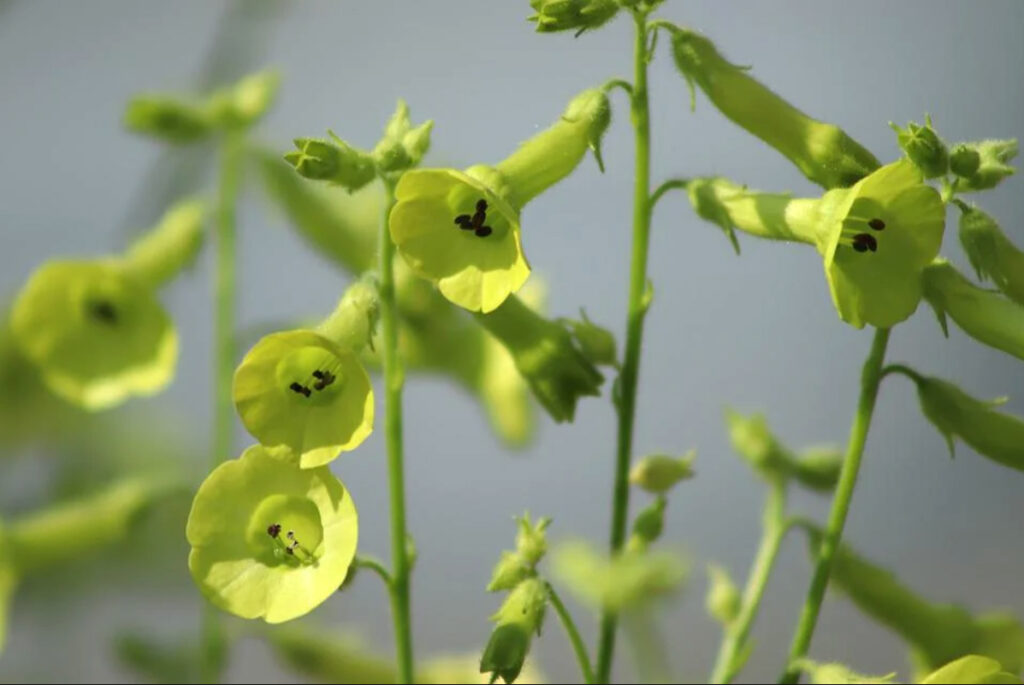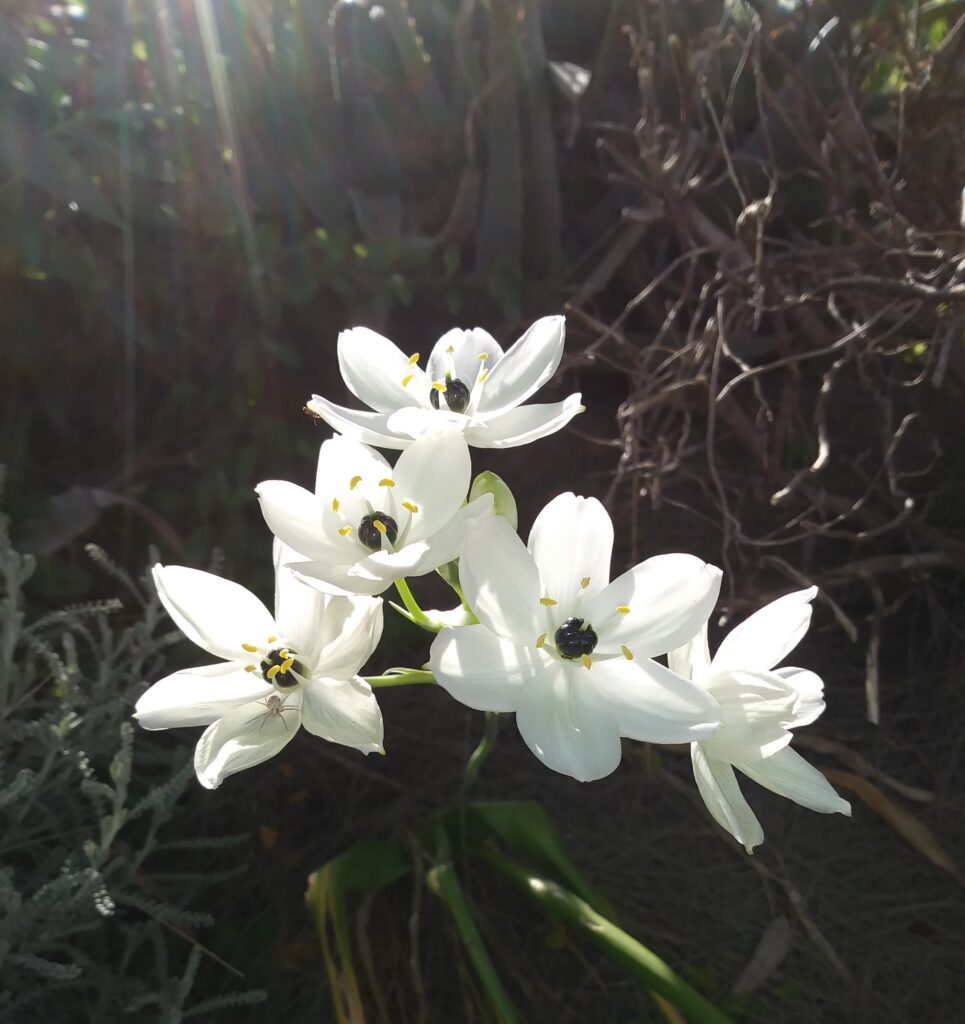By Patricia Jordan
We are always being encouraged by the powers that be to grow more drought-tolerant trees and shrubs and not those that soak up masses of water from underground sources, such as eucalyptus and willows.
Long ago, they were introduced here for that very purpose. Having rid the island of the mosquito-infested swamps, it seems that they are no longer welcome. I have a nostalgic feeling for eucalypts. I love to watch them after a rain storm, as the trunks come alive with colour and the wind catches their leaves and turns them over revealing masses of red flowers beneath, tossing the blue-tinged leaves back into their almost cloud-pruned shapes. We should think long and hard about ridding ourselves of these lovely trees. Twice a year eucalypts swarm with bees, as they hustle to get at the pollen in those red-stamened flowers, and fly back to their hives in order to get on with making the honey.
We should of course be growing more drought-tolerant plants, especially after another long hot summer and I wonder just how many plants labelled as such are lost each year. Plants are only proved drought-tolerant once they have settled into a bed or garden. As you drive around the towns and villages you will see which plants survived the heat – the ubiquitous oleanders along the edges and central reservations of every highway; hibiscus in many colours; bougainvillea tumbling down and over supports; plumbago, earning its common name of ‘sky flower’, with its startling blue flowers; duranta’s lovely blue flowers turning to strings of orange beads catching the sunlight and of course cacti and succulents, although some of them are looking rather parched right now. You probably know already that some trees like frangipani and Delonix regia love humidity and thrive best in the coastal towns. Most of the rest of the plants are drooping like us.
It’s rather early to reflect on successes and failures in September, but this year has been full of surprises. All that lovely rain we had during the winter brought seeds that had laid dormant into life, including some daturas, which I had thought I had lost and a dear little plant with wonderful green flowers belonging to the nightshade family, with the botanical name of Nicotiana langsdorfii! I wonder how it got that name, as langdorfii is German for long village and it started out life in Brazil! It’s a while since I have grown it so have harvested the seeds for sowing later on.
Some plants have disappointed me greatly like hemerocallis which I love, with not a flower, but I will feed them up and maybe they will flourish again next time. Agapanthus africanus, (a misapplied name), with huge blue or white flowers did well, although they only had one flower stem per plant after having had several last year. There are some newer shorter varieties, but I like the stateliness of the larger flower heads. Don’t be tempted to remove the leaves as they begin to turn droop – rather like bulbs, agapanthus need them to make the flowers for next season, so help them along with a feed of Phostrogen. My other South African early flowerers, chasmanthe, known here still as monbretia, which is also an obsolete name, didn’t flower at all. Rather like other plants if they are split up and moved, they sulk for a year or so, so I am hoping for plenty of flowers next spring.
I was amazed at the number of flower heads on the ornithogalum plants around the garden (see Plant of the Month). They reproduce rapidly, but it takes a while for the bulbs to settle in and flower. I decided that they would make more impact in a bigger group, so have replanted some of the larger bulbs together. The same goes for other bulbous flowers too that will be coming into the garden centres later in the month.

Nicotiana langsdorfii
WHAT TO DO IN THE GARDEN IN SEPTEMBER
Keep an eye on your citrus trees for signs of iron and zinc deficiencies now, as the trees haven’t been fed since May. Iron shortage shows itself in a fine network of veins on a very pale leaf, which can be resolved by watering in iron chelate around the base of the tree, remembering that the roots which take up nourishment are not close to the trunk. The dosage is 2 dessertspoons of iron chelate in 10 litres of water.
If your trees have whiteish-yellow blotchy leaves then that is caused by a lack of zinc. This usually appears in young growth and can persist as the leaves grow. By using one dessertspoon of zinc chelate mixed in 5 litres of water, spray the mixture onto the leaves until the moisture runs off, which should resolve this problem. I know that many of you do not like spraying at all and the ‘local’ remedy for iron shortages was to put some iron nails in the ground around the base of the trees.
Mediterranean fruit flies never quite go away, so as the fruit begin to colour up, they will start to appear again. Be warned that it takes only 20 days for an egg to become a mature egg-laying adult!
The garden centres are full of wonderful climbing pot plants now. Passiflora features heavily this month as September 14 is Holy Cross Day celebrated in Stavrovouni and Omodos. Mandevilla splendens looks wonderful in a pot with a trellis to support its enormous growth. Grow these plants in a slightly shaded spot or the leaves will scorch. Feed every two weeks with something like ‘Phostrogen All Purpose Soluble Plant Food’ to ensure repeat flowering.
Hoya is a popular climber, again needing some support and usually likes a more shaded position. It is also known as the ‘honey plant’ or ‘wax plant’ and is a native of Eastern Asia and Australia. It can grow outdoors in Cyprus as long as it has some shade from the midday sun and no low night temperatures. If you live in the mountains then bring it indoors for the winter. It has very fleshy leaves and the extremely pretty pink star-shaped flowers appear on leafless spurs. When the flowers die it is important not to cut off these spurs as new flowers will appear in the same place next season. Growth can be as much as two metres, so give the plant a support or trellis for it to cling onto. The night-scented flowers attract insects, but they do not set seed. Propagation is by layering or stem cuttings. A piece of stem, including one or more pairs of leaves, will quickly root in damp sand or soil. Feed the plant occasionally with a potassium-high feed.
A pretty climber at this time of year is Podranea ricasoliana, another of the several trumpet vines, and a native of South Africa. This sprawling vine’s lovely pink flowers are set off by the dark green leaves. It also known as ‘the Queen of Sheba vine’ and thrives in hot gardens. However, it really does need some strong support, as it can put on a lot of growth each season. It likes to grow in well-drained soil and would benefit from some compost added into the soil from time to time. Although it can cope with heat and indeed drought, it is not for cold gardens.

Ornithogalum arabicum
PLANT OF THE MONTH – Ornithogalum arabicum
Ornithogalum is an old name meaning ‘bird’s milk’ and is derived from two Greek words – ‘ornithos’, which means bird, and ‘gala’, which means milk. The phrase ‘bird’s milk’ was used to describe something wonderful or rare in ancient Greek times. A member of the Asparagaceae family, Ornithogalum is also known as ‘the star of Bethlehem’.
Ornithogalum bulbs really come into their own when planted in large drifts, and will transform your garden or landscape into a beautiful carpet of low-growing lush foliage topped with a profusion of pretty, white, star-shaped flowers. They also look rather splendid growing at the foot of deciduous trees and shrubs, and are a superb choice for containers and window boxes. In fact, many gardeners prefer to plant ornithogalum bulbs in pots, where their spread and growth can be easily contained. Ornithogalum bulbs favour full sun or partial shade in well-drained soil. They can grow 30-45cm in height with straplike fleshy leaves, which appear long before the pretty flowers.
When planting the bulbs, it is advisable to plant them at twice their height and space them roughly 15cm apart, as each plant will make many bulblets. Once established they require very little aftercare and will go on to reward you with an abundance of clusters of pretty, white flowers year after year. Ornithogalum flowers are known for their delightful fragrance and they also make fantastic cut flowers, as not only do they look and smell wonderful, they can last up to an incredible 3 weeks in a floral arrangement.







Click here to change your cookie preferences